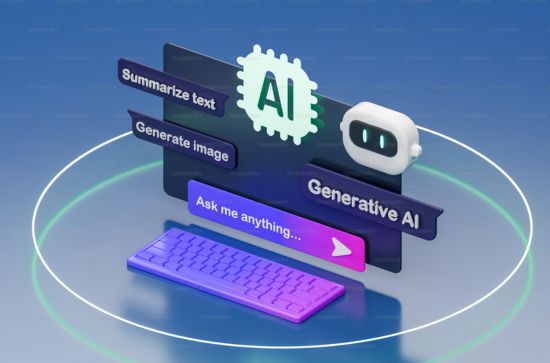What is ChatGPT and How Are People Using It?
Posted on 12 Aug, 2025

Artificial intelligence is no longer confined to specialist fields. It’s now part of everyday tools individuals, businesses and creatives use. One of the most talked about examples is ChatGPT, a language based AI developed by OpenAI. It's designed to understand prompts and respond in a way that feels natural, offering support for a wide range of tasks.
Used across sectors from marketing to software development, ChatGPT is also gaining interest in the design industry. From refining CVs to drafting product descriptions, it’s proving to be a helpful resource for both job seekers and design professionals looking to streamline routine tasks.
Understanding how ChatGPT works and how it’s being used in real world settings can help professionals decide how to use it effectively in their own workflows.
What Is ChatGPT?
OpenAI created the AI chatbot known as ChatGPT. It uses patterns discovered from vast amounts of online data to predict text in response to a user's prompt. As a result, the response appears as though it was written by a human, which makes it a helpful tool for simple tasks, writing content and answering questions.
Because it is based on what is referred to as a "large language model," it has been trained to comprehend and produce language that is similar to that of humans. Although it doesn't think or comprehend like humans do, it can swiftly generate thorough, pertinent answers using the data it has been trained on.
ChatGPT is accessible via a mobile app, web tool and plug-ins that link to other platforms. It keeps changing, getting more accurate and powerful with each iteration. Despite its flaws, a lot of users find it useful for time-saving, idea testing and assisting with daily tasks.
Common Ways People Are Using ChatGPT
Many different types of people and organisations use ChatGPT to streamline tasks, expedite procedures and aid in decision-making. It is a useful tool in many real-world scenarios because it can produce concise, well-organised answers.
Writing and Editing
-
• Supports the creation of cover letters, blog entries, emails and social media captions.
-
• Able to correct grammar, modify tone and make suggestions for clarity enhancements.
-
• Professionals, marketers and students use it to rapidly polish content.
Customer Service and Communication
-
• Drafting answers to commonly asked questions.
-
• Used to automate support for common problems in chatbots.
-
• Helps write client updates and product descriptions.
Research and Learning
-
• Provides summaries of lengthy papers, reports and articles.
-
• Uses simpler language to explain technical terms or concepts.
-
• Encourages brainstorming by providing ideas or suggestions.
Coding and Technical Support
-
• Assists developers in creating or debugging brief code segments.
-
• Gives brief explanations of programming concepts.
-
• Used to convert commands between various programming languages.
While ChatGPT doesn’t replace skilled professionals, it offers a starting point that can save time and reduce repetitive work.
How the Design Industry Is Exploring ChatGPT
The design sector is starting to recognise ChatGPT as a tool that can improve communication, reduce admin and support creative thinking. While it doesn’t replace design skills, it can make certain tasks faster and more manageable, especially for individuals and small teams.
Designers often need to produce written material alongside their visual work. ChatGPT can help draft client proposals, design statements or product descriptions. It’s also useful for writing website bios or portfolio summaries, where clear and confident wording can make a strong impression.
In recruitment, jobseekers use it to refine CVs and cover letters, while employers benefit from help writing job specs and internal documentation. This allows more time to focus on reviewing portfolios and assessing creative ability.
Some designers use ChatGPT as a thinking partner, especially in the early stages of a project. It can offer different ways to phrase an idea or help organise notes into a first draft. While the ideas must still come from the designer, the tool can speed up the process of turning them into client-ready content.
For those working freelance or applying for jobs through platforms like Careers in Design, ChatGPT can be a useful support for managing the demands of both design and business communication.
Responsible Use and Limitations
While ChatGPT offers a wide range of support, it’s important to understand where its limits lie. The tool generates responses based on patterns in data; it doesn’t understand context in the way people do and may occasionally provide inaccurate or outdated information.
Fact-checking remains essential, particularly when using it for client communication or job applications. Relying too heavily on AI-generated content can lead to generic or repetitive language, which may weaken the personal impact needed in design portfolios or CVs.
Creativity, intuition and critical thinking are still human strengths. ChatGPT can support the design process, but it cannot replace the insight gained through experience, conversation or visual understanding. Its best use is as a companion tool to speed up tasks, test ideas or help structure thoughts, while keeping originality and judgment firmly in the hands of the professional.
Used with care, ChatGPT can be a helpful time-saver. But like any tool, it works best when combined with skill, accuracy and thoughtful editing.
Adapting to a Changing Landscape
As AI becomes more common, professionals who understand how to use it wisely will be better prepared for changes in how design services are delivered and how roles are filled. Keeping pace with these tools helps designers remain efficient, adaptable and confident in the job market.
For jobseekers and design professionals looking to stay ahead, Careers in Design provides expert recruitment support and industry-specific opportunities tailored to creative talent. Call 01920 486125 to speak with a specialist who understands both design and your career goals.
Back to blogPosted in: Job Hunting | Tagged: What is ChatGPT How People Are Using ChatGPT
